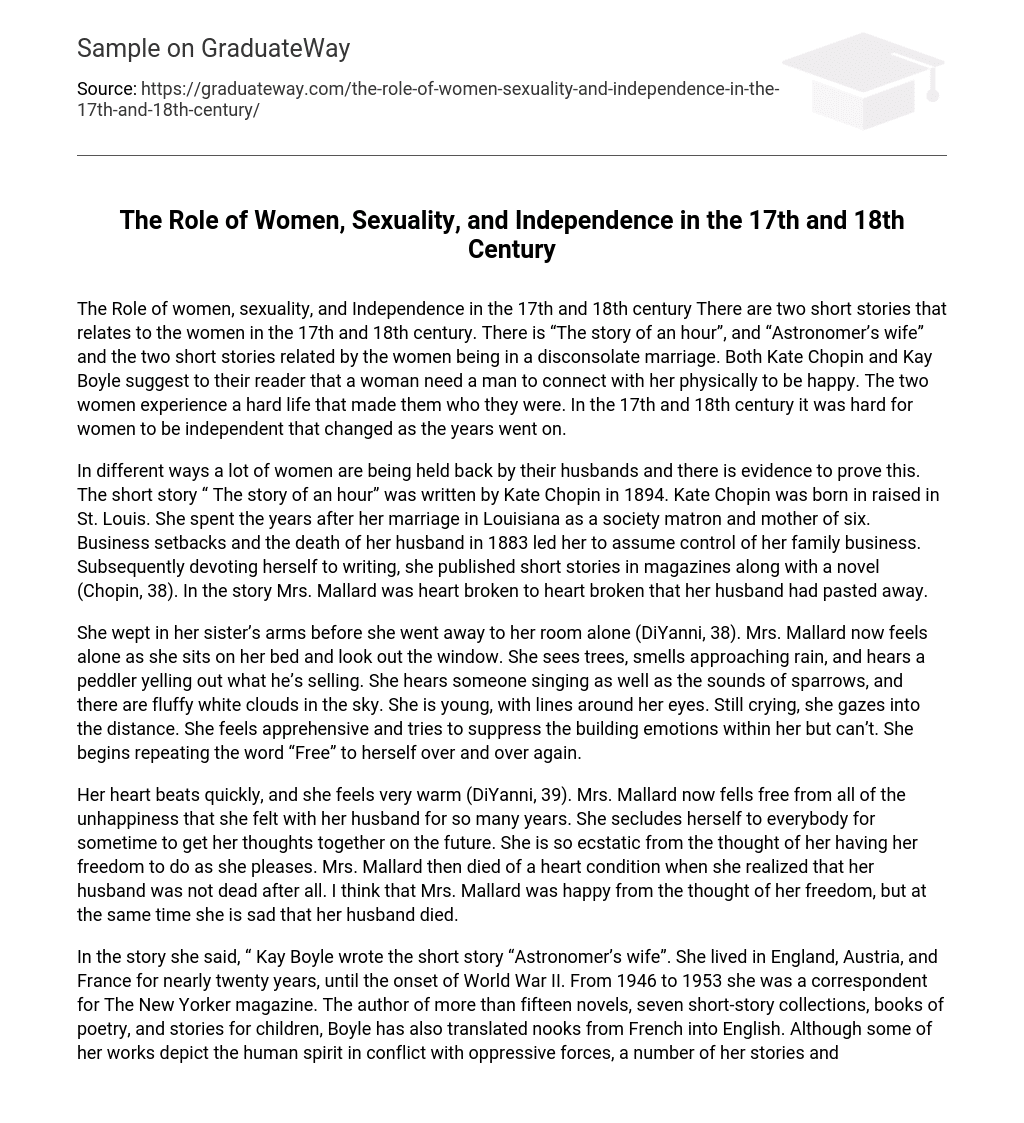The Role of women, sexuality, and Independence in the 17th and 18th century There are two short stories that relates to the women in the 17th and 18th century. There is “The story of an hour”, and “Astronomer’s wife” and the two short stories related by the women being in a disconsolate marriage. Both Kate Chopin and Kay Boyle suggest to their reader that a woman need a man to connect with her physically to be happy. The two women experience a hard life that made them who they were. In the 17th and 18th century it was hard for women to be independent that changed as the years went on.
In different ways a lot of women are being held back by their husbands and there is evidence to prove this. The short story “ The story of an hour” was written by Kate Chopin in 1894. Kate Chopin was born in raised in St. Louis. She spent the years after her marriage in Louisiana as a society matron and mother of six. Business setbacks and the death of her husband in 1883 led her to assume control of her family business. Subsequently devoting herself to writing, she published short stories in magazines along with a novel (Chopin, 38). In the story Mrs. Mallard was heart broken to heart broken that her husband had pasted away.
She wept in her sister’s arms before she went away to her room alone (DiYanni, 38). Mrs. Mallard now feels alone as she sits on her bed and look out the window. She sees trees, smells approaching rain, and hears a peddler yelling out what he’s selling. She hears someone singing as well as the sounds of sparrows, and there are fluffy white clouds in the sky. She is young, with lines around her eyes. Still crying, she gazes into the distance. She feels apprehensive and tries to suppress the building emotions within her but can’t. She begins repeating the word “Free” to herself over and over again.
Her heart beats quickly, and she feels very warm (DiYanni, 39). Mrs. Mallard now fells free from all of the unhappiness that she felt with her husband for so many years. She secludes herself to everybody for sometime to get her thoughts together on the future. She is so ecstatic from the thought of her having her freedom to do as she pleases. Mrs. Mallard then died of a heart condition when she realized that her husband was not dead after all. I think that Mrs. Mallard was happy from the thought of her freedom, but at the same time she is sad that her husband died.
In the story she said, “ Kay Boyle wrote the short story “Astronomer’s wife”. She lived in England, Austria, and France for nearly twenty years, until the onset of World War II. From 1946 to 1953 she was a correspondent for The New Yorker magazine. The author of more than fifteen novels, seven short-story collections, books of poetry, and stories for children, Boyle has also translated nooks from French into English. Although some of her works depict the human spirit in conflict with oppressive forces, a number of her stories and novels explore the human need for love (DiYanni, 62).
In the story Mrs. Ames was a lonely and unhappy wife. Mrs. Ames found that her attention was being drawn elsewhere. There was a plumber that had come to her house to fix a broken pipe that caused a flood. Mrs. Ames described her husband as the “mind” whereas the plumber is the “meat, of all mankind”(Gronning, 52). There are three main topics that I will be discussing throughout my paper and they are the roles, sexuality, and the independence of women in the 17th and 18th century. The roles women in the 17th and 18th century were similar and different in certain way.
The women in the 17th century had more of a strict environment. For example, in the article “The early seventeenth century” it states that unmarried virgins and wives were to maintain silence in the public sphere and give unstinting obedience to father and husbands, though widows had some scope for making their own decisions and managing their affairs (The early seventeenth century). Now once the 18th century came along the women had a little more freedom to maintain their own lives to a certain extent.
For example, in the article “The life of 18th century women” it states that married women’s lives revolved to a large extent around managing the household, a role that in many cases included partnership in running farms or home businesses. Women who traveled with the army were known as camp followers and did so for many reasons: inability to provide for themselves at home; fear of attack; eviction by troops; desire to be with husbands; the attraction of a paying job and rations (even if their pay and rations were minimal), or in some cases as sutlers selling to the army.
During this time well over 20,000 women followed one army of another and transformed camps into small towns. In some ways, women were an important element because they carried out tasks such as laundering and nursing (both of which were paid) which men were unwilling to so and without which the army would have been even more seriously depleted by disease (The life of 18th century women). This is some information on the role, sexuality, and independence of women in the 17th and 18th century.





